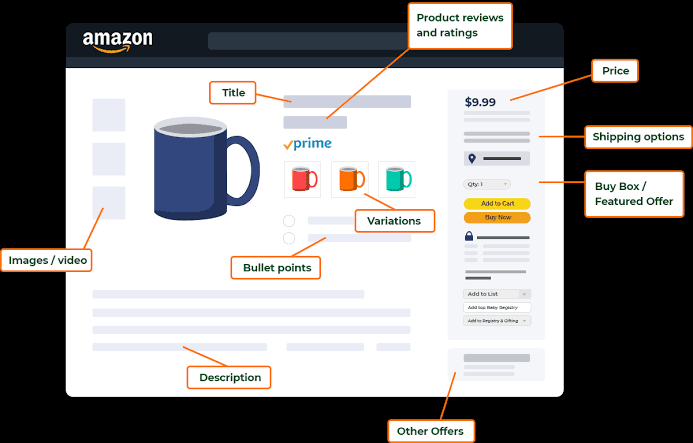Amazon Marketplace is an online platform operated by Amazon that enables third-party sellers to list and sell their products alongside Amazon’s own inventory. It serves as a vast virtual marketplace where millions of buyers and sellers come together to conduct transactions.
The importance of Amazon Marketplace lies in its immense reach, unparalleled customer base, and robust infrastructure, making it an attractive platform for businesses of all sizes. Selling on Amazon Marketplace offers numerous benefits, including access to a global audience, fulfillment services, and marketing opportunities, making it a lucrative opportunity for sellers seeking to expand their reach and grow their business.
As one of the world’s largest online marketplaces, Amazon Marketplace provides sellers with unparalleled access to millions of potential customers worldwide. With over 300 million active customer accounts and a presence in over 180 countries, Amazon offers sellers an extensive reach that would be challenging to achieve through traditional retail channels alone.
By listing their products on Amazon Marketplace, sellers can tap into this vast customer base and increase their sales potential exponentially.Furthermore, Amazon’s reputation as a trusted and reliable online retailer enhances the credibility of sellers who list their products on the platform.
Customers trust Amazon to deliver high-quality products and excellent customer service, which translates into increased confidence in third-party sellers. By associating their brand with Amazon, sellers can leverage this trust to attract more customers and drive sales.
In addition to its broad reach and reputation, Amazon Marketplace offers sellers a range of valuable tools and services to streamline their operations and maximize their success. One of the most significant benefits of selling on Amazon Marketplace is access to Amazon’s Fulfillment by Amazon (FBA) program.
Through FBA, sellers can store their inventory in Amazon’s fulfillment centers and take advantage of Amazon’s world-class logistics network to fulfill orders, handle shipping, and provide customer service. This enables sellers to focus on growing their business while Amazon handles the logistics, saving time, and reducing operational overhead.
Moreover, Amazon Marketplace provides sellers with access to powerful marketing and advertising tools to promote their products and reach more customers. Sellers can create targeted advertising campaigns using Amazon’s advertising platform, allowing them to reach customers based on their search queries, browsing history, and purchasing behavior.
This precision targeting helps sellers maximize their return on investment and drive sales growth.Furthermore, Amazon Marketplace offers sellers valuable insights and analytics tools to track their performance, monitor sales trends, and identify opportunities for growth.
Sellers can access detailed reports on their sales, inventory levels, and customer feedback, allowing them to make data-driven decisions to optimize their business strategy and improve their performance on the platform.
Additionally, selling on Amazon Marketplace provides sellers with access to Amazon’s vast ecosystem of services and resources, including seller support, educational materials, and community forums. Sellers can access personalized support from Amazon’s seller support team to address any issues or concerns they may encounter and receive guidance on optimizing their listings and improving their performance.
Furthermore, Amazon offers a wealth of educational resources, including webinars, tutorials, and guides, to help sellers navigate the complexities of selling on the platform and maximize their success.
How to Get Started As a Seller on Amazon Marketplace

Getting started as a seller on Amazon Marketplace is a straightforward process that offers businesses of all sizes the opportunity to reach millions of customers worldwide and grow their sales. Some of the steps to get started as a seller on Amazon Marketplace, from setting up your seller account to listing your products are as follows:
1. Create Your Seller Account: The first step to selling on Amazon Marketplace is to create a seller account. Visit the Amazon Seller Central website and sign up for an account. You’ll need to provide basic information about your business, including your company name, address, and contact information.
2. Choose Your Selling Plan: Amazon offers two selling plans for sellers: Individual and Professional. The Individual plan is suitable for sellers who plan to sell fewer than 40 items per month and incurs a per-item fee for each sale. The Professional plan is ideal for high-volume sellers and requires a monthly subscription fee but does not charge per-item fees.
3. Set Up Your Payment Method: Once your seller account is created, you’ll need to set up your payment method. Amazon offers several options for receiving payments, including direct deposit to your bank account or Amazon Payments. Choose the payment method that works best for your business.
4. List Your Products: After setting up your seller account and payment method, it’s time to list your products on Amazon Marketplace. Use the “Add a Product” feature in Seller Central to create product listings for each item you want to sell. Be sure to provide detailed and accurate product descriptions, including titles, images, and specifications, to attract customers and improve your listings’ visibility.
5. Set Your Pricing and Shipping Options: Determine your pricing strategy and set competitive prices for your products. Consider factors such as your cost of goods, competitor pricing, and customer demand when setting prices. Additionally, choose your shipping options and set shipping rates based on your preferred carrier and delivery speed.
6. Optimize Your Listings: To maximize your sales potential on Amazon Marketplace, optimize your product listings for search and discoverability. Use relevant keywords in your product titles, descriptions, and bullet points to improve your listings’ visibility in search results. Additionally, utilize high-quality images and compelling product descriptions to attract customers and encourage conversions.
7. Fulfill Orders and Provide Excellent Customer Service: Once your products are listed on Amazon Marketplace, monitor your seller dashboard regularly for new orders. Fulfill orders promptly and provide excellent customer service to ensure a positive buying experience for your customers. Communicate with buyers promptly, respond to inquiries and address any issues or concerns promptly and professionally.
8. Monitor Your Performance and Adjust Your Strategy: Monitor your sales performance and analyze key metrics such as sales volume, conversion rates, and customer feedback. Use this data to evaluate the effectiveness of your sales strategy and identify areas for improvement. Adjust your pricing, listings, and marketing efforts accordingly to optimize your sales and maximize your profitability.
9. Consider Amazon FBA: If you’re looking to streamline your fulfillment process and scale your business, consider enrolling in Amazon’s Fulfillment by Amazon (FBA) program. With FBA, Amazon handles storage, packing, and shipping of your products, allowing you to focus on growing your business while Amazon handles the logistics.
10. Explore Additional Selling Opportunities: Finally, explore additional selling opportunities on Amazon Marketplace, such as Amazon Advertising, Amazon Prime, and Amazon Global Selling. These programs offer additional ways to reach customers, increase sales, and expand your business on the platform.
Read Also: The Ultimate Guide to Shopping at Your Favourite Item Shop
How to List Your Products on Amazon Marketplace

Listing your products on Amazon Marketplace is a crucial step in reaching millions of potential customers and growing your sales. Whether you’re a seasoned seller or new to the platform, effectively listing your products can make a significant difference in your success on Amazon.
1. Create a Seller Account: Before you can list products on Amazon Marketplace, you’ll need to create a seller account. Sign up for an account on the Amazon Seller Central website and provide basic information about your business, including your company name, address, and contact information. Choose between the Individual or Professional selling plan based on your sales volume and business needs.
2. Access Seller Central: Once your seller account is set up, log in to Seller Central, the online portal where you can manage your Amazon seller account. This is where you’ll create and manage your product listings, track sales performance, and handle other aspects of your seller account.
3. Navigate to the Inventory Tab: In Seller Central, navigate to the Inventory tab to access the tools for managing your product listings. Here, you’ll find options to add new products, manage existing listings, and view inventory levels.
4. Add a Product: To create a new product listing, click on the “Add a Product” button in Seller Central. You’ll be prompted to search for the product you want to sell using Amazon’s product catalog. If the product already exists in the catalog, you can select it and proceed to create your listing. If the product is not listed, you can create a new product listing from scratch.
5. Enter Product Details: Next, enter the details for your product listing, including the product title, description, brand, manufacturer, and other relevant information. Be sure to provide accurate and detailed information to help customers make informed purchasing decisions. Include high-quality images of your product to showcase its features and attract buyers.
6. Set Pricing and Shipping Options: After entering the product details, set your pricing and shipping options for the listing. Determine your selling price based on factors such as your cost of goods, competitor pricing, and market demand. Choose your shipping options and set shipping rates based on your preferred carrier and delivery speed.
7. Provide Product Identifiers: Amazon requires sellers to provide product identifiers such as UPC, EAN, or ISBN for most products. These identifiers help Amazon match your listing to the correct product in its catalog and ensure accurate product information for customers. Enter the product identifiers accurately to avoid listing errors and ensure compliance with Amazon’s requirements.
8. Select Product Category and Attributes: Choose the appropriate product category and attributes for your listing to help customers find your product when searching on Amazon. Selecting the correct category and providing relevant attributes will improve the visibility of your listing and increase the likelihood of attracting potential buyers.
9. Optimize Your Listing: To maximize the visibility and performance of your listing, optimize it for search and conversion. Use relevant keywords in your product title, description, and bullet points to improve your listing’s search ranking and attract organic traffic. Additionally, utilize high-quality images and compelling product descriptions to engage customers and encourage conversions.
10. Review and Publish Your Listing: Before publishing your listing, review all the information carefully to ensure accuracy and completeness. Check for any errors or missing information, and make any necessary revisions. Once you’re satisfied with the listing, click the “Publish” button to make it live on Amazon Marketplace.
11. Monitor Performance and Make Adjustments: After your listing is live, monitor its performance regularly and track key metrics such as sales volume, conversion rates, and customer feedback. Use this data to evaluate the effectiveness of your listing and make adjustments as needed to optimize performance. Experiment with different pricing strategies, keywords, and product variations to improve your listing’s visibility and sales.
Read Also: How to Calculate Net Income: A Step-By-Step Guide
What Are the Ways of Which You Can Optimize Your Performance and Sales on Amazon Marketplace

Optimizing your performance and sales on Amazon Marketplace is essential for maximizing your success and growing your business on the platform. By implementing effective strategies and leveraging Amazon’s tools and resources, you can improve your visibility, attract more customers, and increase your sales. These strategies include:
1. Optimize Your Product Listings: Ensure that your product listings are well-optimized for search and conversion by using relevant keywords, high-quality images, and detailed product descriptions. Provide accurate and informative product details to help customers make informed purchasing decisions.
2. Offer Competitive Pricing: Pricing plays a crucial role in determining your sales performance on Amazon Marketplace. To optimize your sales, it’s essential to offer competitive pricing that is attractive to customers while still allowing you to maintain profitability. Consider factors such as your cost of goods, competitor pricing, and market demand when setting your prices.
3. Utilize Amazon FBA (Fulfillment by Amazon): Amazon FBA is a powerful tool for optimizing your sales and performance on Amazon Marketplace. By enrolling in FBA, you can take advantage of Amazon’s world-class logistics network to store, pack, and ship your products to customers. This not only streamlines your fulfillment process but also enables you to offer fast and reliable shipping options to customers, which can improve your sales and customer satisfaction.
4. Leverage Amazon Advertising: Amazon offers several advertising options to help sellers increase their visibility and sales on the platform. Sponsored Products, Sponsored Brands, and Sponsored Display ads allow you to promote your products to relevant audiences and drive traffic to your product listings. By strategically targeting your ads and optimizing your campaigns, you can increase your product visibility and attract more customers to your listings.
5. Monitor and Manage Your Inventory: Effective inventory management is essential for optimizing your performance and sales on Amazon Marketplace. Monitor your inventory levels regularly and replenish stock as needed to avoid running out of popular products. Additionally, consider using inventory forecasting tools to predict demand and optimize your inventory levels to meet customer demand while minimizing excess inventory.
6. Solicit and Respond to Customer Feedback: Customer feedback plays a crucial role in your performance and sales on Amazon Marketplace. Encourage customers to leave reviews and feedback on your products, and respond promptly and professionally to any feedback or inquiries you receive. Positive reviews can improve your product rankings and attract more customers, while addressing negative feedback can help mitigate potential issues and improve customer satisfaction.
7. Optimize Your Product Images and Descriptions: High-quality product images and compelling product descriptions are essential for optimizing your sales and conversion rates on Amazon Marketplace. Use professional-quality images that showcase your products from multiple angles and highlight their features and benefits. Additionally, write clear and concise product descriptions that address customer pain points and answer any questions they may have about the product.
8. Stay Informed About Amazon’s Policies and Guidelines: Amazon regularly updates its policies and guidelines for sellers, so it’s essential to stay informed about any changes that may affect your business. Familiarize yourself with Amazon’s Seller Central and regularly check for updates and announcements from Amazon. By staying informed, you can ensure that your business remains compliant with Amazon’s policies and guidelines and avoid any potential issues that could impact your performance and sales.
9. Offer Excellent Customer Service: Providing excellent customer service is key to optimizing your performance and sales on Amazon Marketplace. Be responsive to customer inquiries and messages, and resolve any issues or concerns promptly and professionally. By delivering exceptional customer service, you can build trust and loyalty with your customers and increase the likelihood of repeat purchases and positive reviews.
10. Analyze Your Performance and Make Data-Driven Decisions: Regularly analyze your performance metrics, such as sales volume, conversion rates, and customer feedback, to identify areas for improvement and optimization.
Use this data to make data-driven decisions about your pricing, inventory management, advertising strategies, and product listings. By continuously optimizing your approach based on performance data, you can maximize your success and grow your business on Amazon Marketplace.
In conclusion, optimizing your performance and sales on Amazon Marketplace requires a strategic approach and ongoing effort. By implementing the strategies outlined above and leveraging Amazon’s tools and resources, you can improve your visibility, attract more customers, and increase your sales on the platform. By staying informed, staying proactive, and continuously optimizing your approach, you can maximize your success and achieve your business goals on Amazon Marketplace.
Read Also: Best Home Workout Routine For Beginners






